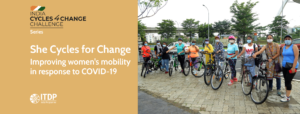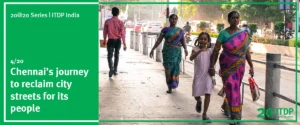Written by Rohit James Edited by Kashmira Medhora Dubash
If life is a theatre, then commuting on Indian urban roads is a Greek tragedy that unfolds daily. Jostling for space, dashing to beat a signal or tip-toeing around oncoming traffic, all these are daily reminders of how desperately the Indian transport system needs an overhaul. According to a Boston Consulting Group survey, a commuter in Mumbai spends 135% more time in road travel than any other Asian city.
Written by Rohit James Edited by Kashmira Medhora Dubash
Yet, our current vehicle-centric transportation planning only adds more vehicles on roads. And beating congestion by adding more roads is a battle that no city has won. It isn’t just the rapid increase in congestion, traffic snarls or travel time, but also the subsequent rise of pollution and road accidents that hamper quality of life in our cities.
Etched in our memories by means of rampant baits (adverts of all sizes and forms), automobiles were perpetuated as the vehicles for our ‘escape from Alcatraz’. Just for one tiny-little gargantuan problem! The light that flickered at the end of that tunnel was decimated by tonnes of reinforced steel and million gallons of cement. That is, the more infrastructure we built to support private motor vehicles the more congestion was created on the streets; resulting in ever-increasing pollution levels.
As per a report, published by the University of Chicago, automobiles contribute a quarter of the PM 2.5 released into the atmosphere. “Particulate pollution cuts global life expectancy short by nearly two years; and in India, it is an average of four years! In comparison, smoking cuts global life expectancy by 1.6 years,” states the report.
And in all of this, commute hours only managed to worsen. Hence, countries at large are adopting sustainable and ecological public transport measures such as buses. But in India, there still exists a certain disdain when it comes to using buses in the urban scenario.
In order to rid ourselves of this baseless confirmation bias, we need to understand what these myths are and where they stand when viewed with rationale.

Beating congestion by adding more roads is a battle that no city has won
Beating congestion by adding more roads is a battle that no city has won
“Every rupee spent by a city on public transport boosts its economy by four rupees!” said Mr Khatua, Director of Mumbai Technical Support Unit, at a workshop on the Maharashtra State Urban Transport Policy. Succinctly put, the senior officer magnifies the need of the hour: sustainable public transport systems.
Closely looking at Maharashtra’s urban population, it is expected to increase by a whopping 30% in the next decade and by another 50% in the years to follow. Going by the present-day scenario of urban commute in the state, the future seems too hazy. To counter these issues, the Urban Development Department of the state has drafted and published the Maharashtra Urban Mobility Policy.
With sustainability at its core, the policy looks to develop transport systems in accordance. So efforts will be concentrated on urban transit systems which reduces burden on resources and most importantly, offers an equal space to every commuter. Hence, facilitating walking, cycling and usage of public transport.

Urban Development Department
Urban Development Department
How the policy came about
In 2006, the National Urban Transport Policy (NUTP) was laid out as a guidance for transportation planning in Indian cities. It prioritized the movement of people and not vehicles in cities, emphasizing on adequate road space for sustainable transport modes, such as walking, cycling and public transport. However, the NUTP mostly existed as a term of reference on papers.
You may ask, so why bring it up now? Well, Maharashtra is taking strides to plug this gap, making it the first state to define its own transportation policy. This further ensures that its urban transportation projects are consistent with NUTP. In June 2017, the Urban Development Department released a draft of the policy. To ensure transparency and insight on feasibility the process was participatory, taking into consideration comments and suggestions of citizens and officials from various cities.

Consultation with Pune Municipal Corporation
Consultation with Pune Municipal Corporation

Consultation with Nashik Municipal Corporation
Consultation with Nashik Municipal Corporation
In all of this the ITDP India Programme provided technical guidance to the Urban Development Department, and the department is now in the last stages of finalizing the draft.
What it offers
Applicable to all urban areas of the state, the policy envisions transport modes which are safe, reliable, sustainable and accessible for citizen from all walks of life. Additionally, focusing on women’s safety.
The key objectives that the policy will enforce upon cities are:
· Safety and convenience offered to pedestrians, cyclists and public transport users.
· Reducing usage of personal vehicles
· Our transportation infrastructure must be is universally accessible
· Road fatalities should be drastically reduced
· Ambient air quality should meet or exceed Central Pollution Control Board norms
All this is easier said than done, of course. Hence, the policy offers tangible metrics for infrastructure implementation, followed up with support and training provided by the state government.
The policy also helps to detangle the bureaucratic red-tape and ensures a coherent approach is in store. Cities with a population of 10 lakh or more are expected to establish a Unified Metropolitan Transport Authority and an Urban Transport Fund to manage financial resources for all transportation projects. This will ensure that each agency works in coordination and follows an identical vision.
In conclusion, the policy offers a glimmer of hope; and we say glimmer because there are still many a miles to go and stretches to be reclaimed for equal distribution. But this clearly is a step in the right direction which will impact and influence other states to follow suit. In essence, Maharashtra has shown its wherewithal to get with the times and be the trailblazer that leads by example.


